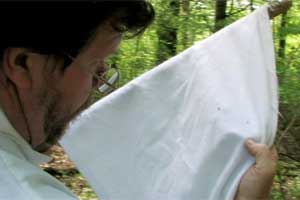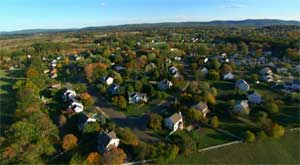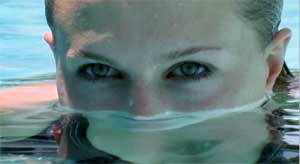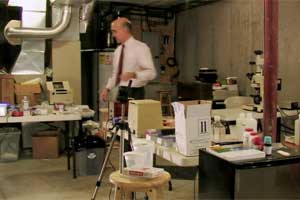 It took Andy Abrahams Wilson four years to film the patients, doctors and controversies documented in his nonfiction film Under Our Skin, about the hotly argued sources and treatments of Lyme disease. Another year has passed since its first theatrical showing -- and it's time for a national TV program or network to step up and televise it...
It took Andy Abrahams Wilson four years to film the patients, doctors and controversies documented in his nonfiction film Under Our Skin, about the hotly argued sources and treatments of Lyme disease. Another year has passed since its first theatrical showing -- and it's time for a national TV program or network to step up and televise it...
Under Our Skin, produced by Open Eye Pictures, takes what seems to be a straightforward subject -- the spread and treatment of Lyme disease -- and turns it into a detective story, a romance, an inspirational drama, a conspiracy thriller and a science lesson, all in one.
 Had writer-director-photographer Wilson selected his subject, swooped in, gathered evidence and left, his movie would have only a fraction if its power. By sticking around for years, and tracking both the degeneration and the improvements of certain patients, Under Our Skin presents a more complete case. And, in the end, an unforgettable one.
Had writer-director-photographer Wilson selected his subject, swooped in, gathered evidence and left, his movie would have only a fraction if its power. By sticking around for years, and tracking both the degeneration and the improvements of certain patients, Under Our Skin presents a more complete case. And, in the end, an unforgettable one.
The science of Lyme disease isn't avoided or underplayed. Under the microscope, we learn of spirochetes and biofilms. In the woods, we walk with a Lyme expert who casually sweeps a white cloth along the ground, and effortlessly gathers male, female and nymph ticks. In newspaper and TV reports, we are reminded of the origin of the disease's name, and recent fights over the proper treatment and diagnosis of Lyme disease.

After a while, the overhead shots of idyllic autumn landscapes, whether unblemished forests or tree-laden suburbs, take on a tone that is less serene than sinister. And through home movies and years of Wilson's own photography, we get to know lots of people who insist they suffer from Lyme disease -- and see them at such polar opposites of health that empathy is unavoidable.
 There's Mandy, for example, a beautiful woman whose wedding video shows a vibrant young lady -- but who, when we meet her, is reduced to floating in a swimming pool to get any sense of relief. Over the course of the documentary, she gets much worse -- then, after changing doctors and medications, much better.
There's Mandy, for example, a beautiful woman whose wedding video shows a vibrant young lady -- but who, when we meet her, is reduced to floating in a swimming pool to get any sense of relief. Over the course of the documentary, she gets much worse -- then, after changing doctors and medications, much better.
Other patients are shown, and other doctors heard from. One of the things this documentary does so well is gather the shared experiences of all these patients into rapid-file strings of testimony, filmed the same way over a light grey background. Number of doctors seen? Different types of diagnoses? Total amount of medical costs? Persistent symptoms? They all answer the same questions, and their answers really add up.
 One fascinating figure in Under Our Skin is Dr. Alan MacDonald, who has dedicated decades of his life to disproving the prevailing medical theory that Lyme disease is "easy to treat, easy to cure." In a makeshift laboratory in his home basement, he keeps looking for clues to prove his idea that Lyme is a chronic illness -- and, eventually, finds and publishes a report linking Lyme to such accepted, but as yet unexplained, chronic diseases as Alzheimer's and Parkinson's.
One fascinating figure in Under Our Skin is Dr. Alan MacDonald, who has dedicated decades of his life to disproving the prevailing medical theory that Lyme disease is "easy to treat, easy to cure." In a makeshift laboratory in his home basement, he keeps looking for clues to prove his idea that Lyme is a chronic illness -- and, eventually, finds and publishes a report linking Lyme to such accepted, but as yet unexplained, chronic diseases as Alzheimer's and Parkinson's.
And just when certain doctors are shown offering treatments which appear to help their patients with long-suffering Lyme symptoms, those same doctors are attacked -- accused of malpractice and judged by medical boards. The motives for these peer reviews may have something to do with insurance companies and health-care costs, which makes this documentary very timely, as well as quite infuriating.
The last third of Under Our Skin may, so to speak, tick you off. But it also is very heartening, offering hope merely by taking the time and effort to follow its subjects through years of controversial treatment. What happens to them should be seen by everyone.
As should this feature-length documentary. It appears to be a fine fit for Frontline, P.O.V. or Independent Lens on PBS, or as part of HBO's already impressive commitment to nonfiction filmmaking, or a good acquisition by any cable network looking to enhance its own schedule and reputation. Here's hoping, before long, you can see what I've seen, and be similarly educated and impressed.